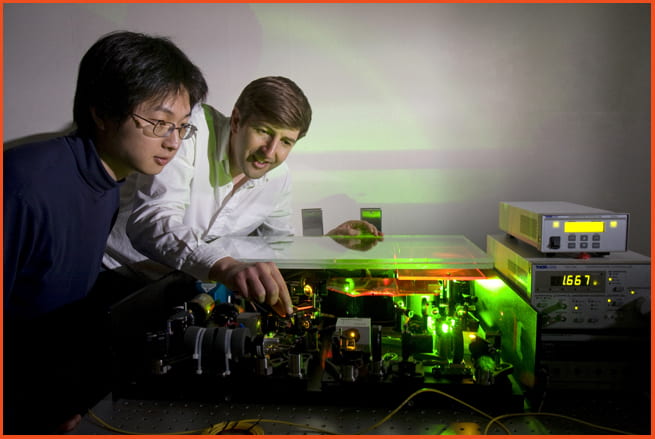2008 Photos of the Month

October
Our development of an open-access, very-low-field MRI system for posture-dependent human lung imaging has recently been publicized by the Harvard Gazette and the Harvard News Office. The article describes how this project grew out of the group’s larger atomic physics activities, and also includes quotes from our biomedical collaborators at Massachusetts General Hospital (MGH). We hope to move the MRI system to the Martinos Center for Biomedical Imaging at MGH – Charlestown in 2009. The article originally appeared on the Harvard Gazette website in early October, as shown above, and soon after that in the print version of the Harvard Gazette. The website version shows a photo of Ron in the imager, trying to detect the 200 Amp electrical currents in the gradient coils of the MRI system, however the print version used a different photo of Ron in a more sedate position. Shortly after appearing in the Gazette, the article also appeared on the HarvardScience News Website.

An exciting new project just beginning in the Walsworth group is the development of technology to allow the detection of magnetic fields with high sensitivity on the nanometer scale, using a “nitrogen-vacancy centre” in diamond. We have termed this device the “nitrogen-vacancy diamond magnetometer”, or NV-B imager. The devices may pave the way for a general method for detecting magnetic fields from a single molecule, a task which has so far proven elusive. The group’s initial work in this area, in collaboration with the Lukin group at the Harvard Department of Physics, has just been published in Nature, with additional commentary, in the October 02 issue.

August
July was a very busy month for the group members involved in the laser-based “astro-comb” project. This new laser-measuring device will provide a critical advance in the resolution of current planet-finding techniques, making the discovery of Earth-sized planets outside our solar system, called “exoplanets”, possible. After lab-based development work during the first half of 2008, the equipment was disassembled and shipped to the MMT Observatory in Arizona, a 6.5-meter-diameter optical telescope located on the summit of Mt. Hopkins, 30 miles south of Tucson, Arizona. David, Claire, Chih-Hao, and Alex spent over two weeks there, re-assembling the astro-comb, and interfacing it to spectrographs already in use on the smaller telescopes at MMT. The above picture shows David and Alex hard at work during the re-assembly stage in Arizona.

June
Conference season has been with us again recently. Among a number of trips by group members, Rachel and Alison attended the International Society for Magnetic Resonance in Medicine annual meeting, held in Toronto, Canada, in May. There were numerous lecture sessions and many posters on MRI with hyperpolarized media, including noble gases and condensed phases, as well moelcuar imaging appoaches with MRI, MRI hardware, and other techniques. Rachel is shown presenting her poster on the orientation dependence of pulmonary oxygen concentration.

Before Rachel and Alison headed off to see the city views from the nearby CN Tower!

April
An exciting new project just beginning in the Walsworth group is the development of a laser-based astro-comb. The new laser-measuring device will provide a critical advance in the resolution of current planet-finding techniques, making the discovery of Earth-sized planets outside our solar system possible. The discovery of such planets, called “exoplanets”, is one of the hottest fields in astronomy. The work was recently published in Nature, with extensive commentary in the April 03 issue. The work has also featured in a Harvard News release, and the MIT Technology Review. Here, Ron and Chih-Hao are shown inspecting the novel laser used in this project.

An exciting new project just beginning in the Walsworth group is the development of a laser-based astro-comb. The new laser-measuring device will provide a critical advance in the resolution of current planet-finding techniques, making the discovery of Earth-sized planets outside our solar system possible. The discovery of such planets, called “exoplanets”, is one of the hottest fields in astronomy. The work was recently published in Nature, with extensive commentary in the April 03 issue. The work has also featured in a Harvard News release.

An exciting new project just beginning in the Walsworth group is the development of a laser-based astro-comb. The new laser-measuring device will provide a critical advance in the resolution of current planet-finding techniques, making the discovery of Earth-sized planets outside our solar system possible. The discovery of such planets, called “exoplanets”, is one of the hottest fields in astronomy. The work was recently published in Nature, with extensive commentary in the April 03 issue. The work has also featured in a Harvard News release, and the MIT Technology Review.

January
Ross was recently invited to Norway to present a key-note lecture on biological MRI applications to the bi-annual Norwegian National NMR conference. The conference was held in Oppdal, a small ski-resort town about 2 hours drive from the coastal city of Trondheim. Ross gave an overview of the use of hyperpolarized helium for lung imaging, and then a summary of our recent studies of posture-dependance on lung function using our open-access MRI scanner. The pictures show Ross giving his presentation, and the view from the conference hotel.
